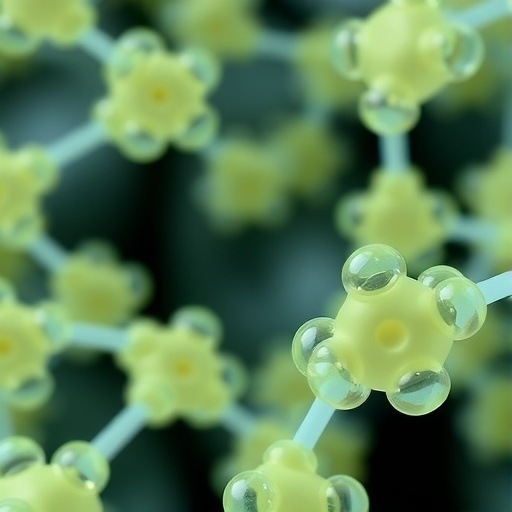
In a groundbreaking development that stands to revolutionize the field of lipid chemistry and functional food design, researchers have unveiled a novel enzymatic method for synthesizing structured lipids that combine the nutritional benefits of polyunsaturated fatty acids with the desirable physical properties of medium-chain fatty acids. This cutting-edge approach hinges on the lipase-catalyzed modification of DHA-enriched glycerides and capric acid, forging a new class of structured lipids with promising implications for health, nutrition, and bioactive compound delivery.
Structured lipids, designed to optimize metabolic pathways and enhance nutrient bioavailability, have long fascinated scientists aiming to tailor fats for specific physiological effects. Docosahexaenoic acid (DHA), a vital omega-3 fatty acid, is celebrated for its critical role in brain development, cardiovascular protection, and anti-inflammatory activity. However, its incorporation into functional foods often faces challenges related to stability, solubility, and digestibility. By selectively integrating capric acid, a medium-chain saturated fatty acid known for its rapid metabolism and energy-boosting properties, into DHA-rich glycerides, the research team has opened new avenues for creating lipids that marry health benefits with functional efficacy.
Central to this innovative process is the enzymatic catalysis mediated by lipases—biological catalysts that facilitate ester bond formation and exchange under mild conditions with remarkable specificity. Employing lipase enzymes not only preserves the delicate omega-3 structures from oxidative damage but also offers regioselective control over fatty acid positioning on the glycerol backbone. This precision allows the synthesis of triacylglycerols with optimized fatty acid configurations, which can directly influence digestion kinetics, absorption efficiency, and ultimately, the bioactivity of the lipids consumed.
.adsslot_OiyI9Nctbo{width:728px !important;height:90px !important;}
@media(max-width:1199px){ .adsslot_OiyI9Nctbo{width:468px !important;height:60px !important;}
}
@media(max-width:767px){ .adsslot_OiyI9Nctbo{width:320px !important;height:50px !important;}
}
ADVERTISEMENT
The methodology involves a meticulous balance of reaction parameters, including temperature, substrate molar ratios, and enzyme concentrations, to achieve high conversion rates and product purity. The process harnesses the inherent affinity of lipases toward specific acyl donors, facilitating the targeted substitution of fatty acid residues without compromising the overall lipid structure. Such enzymatic finesse contrasts starkly with traditional chemical methods that often require harsh reagents, elevated temperatures, or yield heterogeneous products with inconsistent functional properties.
Beyond the biochemical intricacies, the designed structured lipids exhibit enhanced physicochemical properties that make them attractive candidates for incorporation into a broad spectrum of food matrices. Improved oxidative stability ensures longer shelf life and preserves the integrity of polyunsaturated components during processing and storage. Additionally, altered melting behaviors and crystallization patterns afford manufacturers greater flexibility in product formulation, spanning from emulsions and spreads to encapsulated supplements.
The health implications of this bioengineered lipid class are equally compelling. By delivering DHA in a medium-chain triglyceride (MCT) context, the structured lipids potentially unlock synergistic metabolic benefits, ranging from enhanced brain uptake of omega-3s to accelerated energy availability from capric acid metabolism. This dual benefit could be transformative for populations with increased nutritional demands, including infants, the elderly, and individuals managing chronic inflammatory conditions.
Moreover, the enzymatic synthesis aligns perfectly with the growing global impetus toward sustainable and environmentally friendly production technologies. Lipase-catalyzed reactions occur under benign conditions, minimize waste generation, and reduce reliance on petrochemical-derived solvents or catalysts. Such green chemistry principles not only lower the environmental footprint of lipid manufacturing but also cater to consumer demands for cleaner label products.
The versatility of this approach further extends to tailoring lipid structures for targeted delivery of bioactives beyond omega-3 fatty acids. Future adaptations of the method could facilitate the incorporation of fat-soluble vitamins, antioxidants, or pharmaceuticals into the lipid matrices, enhancing stability and controlled release profiles. This adaptability places enzymatically synthesized structured lipids at the forefront of nutraceutical and pharmaceutical innovation.
Analytical characterization of these novel structured lipids revealed distinct molecular compositions confirmed via spectroscopic techniques and chromatographic profiling, signifying the successful integration of capric acid moieties into DHA-rich glycerides. Thermal analyses underlined their superior stability profiles, which bode well for diverse food processing environments. Importantly, in vitro digestion studies underscore improved lipolysis patterns, supporting the hypothesis of enhanced bioavailability.
This breakthrough heralds a new era in lipid modification technology, one where enzyme catalysis empowers precision tailoring of fats to meet the demands of specialized nutrition and functional food applications. As the global market increasingly pivots towards health-conscious eating patterns, such innovations will undoubtedly drive the development of next-generation lipid-based ingredients that reconcile taste, health, and technological performance.
The research paves the way for scalable production strategies as well, with the potential to seamlessly integrate into existing industrial workflows. Optimization of lipase immobilization and process engineering promises to elevate yields and cost efficiency, facilitating commercial adoption. Collaborative efforts between academia and industry could accelerate translation from bench to market, maximizing societal impact.
Intriguingly, the successful fusion of DHA-enriched glycerides and capric acid via enzymatic pathways reflects the broader trend of leveraging biocatalysis for molecular precision in food science. The study contributes robust empirical evidence supporting enzymatic structured lipid synthesis as a viable and versatile platform technology, inspiring further research into the rational design of lipid architectures.
In conclusion, this novel lipase-catalyzed approach to constructing structured lipids deftly combines the nutritive power of omega-3 fatty acids with the metabolic advantages of medium-chain fats. Its demonstration signals a promising leap forward in the design of functional lipids, with far-reaching implications for health, industry, and sustainability. As more detailed clinical evaluations and industrial scaling efforts unfold, this innovation stands poised to redefine lipid utilization in modern nutrition.
Subject of Research: Enzymatic synthesis of structured lipids combining DHA-enriched glycerides and capric acid.
Article Title: Novel lipase-catalyzed synthesis of structured lipids from DHA-enriched glycerides and capric acid.
Article References:
Cho, Y., Lee, C., Lee, J. et al. Novel lipase-catalyzed synthesis of structured lipids from DHA-enriched glycerides and capric acid. Food Sci Biotechnol (2025). https://doi.org/10.1007/s10068-025-01958-0
Image Credits: AI Generated
DOI: https://doi.org/10.1007/s10068-025-01958-0
Tags: bioactive compound deliveryDHA-enriched structured lipidsdocosahexaenoic acid health benefitsenzymatic modification of glyceridesfunctional food design innovationslipase-catalyzed synthesislipid chemistry advancementsmedium-chain fatty acids benefitsmetabolic pathway optimizationnutrient bioavailability enhancementpolyunsaturated fatty acids nutritionstructured lipids for health





